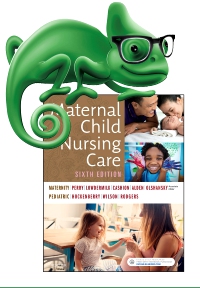
Elsevier Adaptive Quizzing for Perry Maternal Child Nursing Care, 6th Edition
Elsevier Adaptive Quizzing - Next Generation

Corresponding chapter-by-chapter to Maternal Child Nursing Care, 6th Edition, Elsevier Adaptive Quizzing (EAQ) integrates seamlessly into your course to help students of all skill levels focus their study time and effectively prepare for class, course exams, and summative exams. EAQ is comprised of a bank of high-quality practice questions that allows students to advance at their own pace — based on their performance — through multiple mastery levels for each chapter. A comprehensive dashboard allows students to view their progress and stay motivated. The educator dashboard and reporting capabilities enable you to monitor the activity of individual students, assess overall class performance, and identify areas of strength and weakness, ultimately helping to achieve improved learning outcomes.
Newer Edition Available
Elsevier Adaptive Quizzing for Perry Maternal Child Nursing Care
-
- UNIQUE! Elsevier’s trusted, market-leading content serves as the foundation for all questions, which are written, reviewed, and leveled by experienced educators, item writers, and authors. Each question is accompanied by a specific chapter and page within your Elsevier text for convenient reference.
- UNIQUE! Essential test-taking tips and strategies help students learn how to successfully dissect and tackle different question types and improve test-taking skills for both course exams and summative exams.
- Confidence level indicators allow students to indicate their confidence when submitting answers, providing valuable insight into areas where they might be overconfident and require further study.
- UNIQUE! Students can practice in Study Mode, which provides immediate feedback, or in Exam Mode where the quiz is timed and results are summarized at the end.
- UNIQUE! In addition to detailed rationales for each question, select questions include interactive, multimedia resources such as illustrations, animations, videos, audio clips, summary tables, and study tips to engage students with different learning styles and reinforce challenging material.
- Engaging, easy-to-use interface ensures that students and educators can navigate through the program with ease.
- Multiple mastery levels for each chapter allow students to progress from one level to the next based on individual performance.
- Alternate item format questions — including multiple-response, fill-in-the-blank, prioritizing, graphic options, chart/exhibit, video, audio, and hot spot — provide valuable summative exam preparation.
- The comprehensive student dashboard allows each individual to view their personal learning progress with summaries of their strengths, weaknesses, mastery levels, and normative data.
- A robust educator dashboard highlights usage and performance summaries; areas of strength and weakness tied to chapters for each student and class; and normative data that educators can use to modify lectures or class activities accordingly.
-
PART 1: Maternity Nursing
UNIT 1: INTRODUCTION TO MATERNITY NURSING
1. 21st Century Maternity Nursing
2. Community Care: The Family and Culture
UNIT 2: REPRODUCTIVE YEARS
3. Assessment and Health Promotion
4. Reproductive System Concerns
5. Infertility, Contraception, and Abortion
UNIT 3: PREGNANCY
6. Genetics, Conception, and Fetal Development
7. Anatomy and Physiology of Pregnancy
8. Nursing Care of the Family During Pregnancy
9. Maternal and Fetal Nutrition
10. Assessment of High Risk Pregnancy
11. High Risk Perinatal Care: Preexisting Conditions
12. High Risk Perinatal Care: Gestational Conditions
UNIT 4: CHILDBIRTH
13. Labor and Birth Processes
14. Pain Management
15. Fetal Assessment During Labor
16. Nursing Care of the Family During Labor and Birth
17. Labor and Birth Complications
UNIT 5: POSTPARTUM PERIOD
18. Maternal Physiologic Changes
19. Nursing Care of the Family during the Postpartum Period
20. Transition to Parenthood 21. Postpartum Complications
UNIT 6: NEWBORN
22. Physiologic Adaptations of the Newborn
23. Nursing Care of the Newborn and Family
24. Newborn Nutrition and Feeding
25. The High Risk Newborn
PART 2: PEDIATRIC NURSING
UNIT 7: CHILDREN, THEIR FAMILIES, AND THE NURSE
26. 21st Century Pediatric Nursing
27. Family, Social, Cultural, and Religious Influences on Child Health Promotion
28. Developmental and Genetic Influences on Child Health Promotion
UNIT 8: ASSESSMENT OF THE CHILD AND FAMILY
29. Communication, History, and Physical Assessment
30. Pain Assessment and Management
UNIT 9: HEALTH PROMOTION AND SPECIAL HEALTH PROBLEMS
31. The Infant and Family
32. The Toddler and Family
33. The Preschooler and Family
34. The School-Age Child and Family
35. The Adolescent and Family
UNIT 10: SPECIAL NEEDS, ILLNESS, AND HOSPITALIZATION
36. Chronic Illness, Disability, and End-of-Life Care
37. Cognitive and Sensory Impairment
38. Family-Centered Care of the Child During Illness and Hospitalization
39. Pediatric Variations of Nursing Interventions
UNIT 11: HEALTH PROBLEMS OF CHILDREN
40. Respiratory Dysfunction
41. Gastrointestinal Dysfunction
42. Cardiovascular Dysfunction
43. Hematologic and Immunologic Dysfunction
44. Genitourinary Dysfunction
45. Cerebral Dysfunction
46. Endocrine Dysfunction
47. Integumentary Dysfunction
48. Musculoskeletal or Articular Dysfunction
49. Neuromuscular or Muscular Dysfunction
Appendix A: Growth Measurements
Appendix B: Common Laboratory Tests
Appendix C: Pediatric Vital Signs and Parameters
-
This product is available in the following formats:















